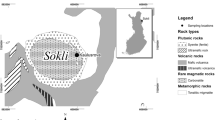Abstract
Negative charge and related characteristics of dioctahedral micas have been investigated by conducting artificial weathering studies on a muscovite from Ontario, Canada, and saprolitic micas from Virginia. Emphasis is given to the relationship between loss of potassium, increase in net negative charge, or cation exchange capacity, and expansion characteristics.
Boiling solutions of acetic acid, sodium chloride and magnesium chloride removed potassium and sodium from a saprolitic mica but produced a negligible increase in cation exchange capacity. Expansion of the mica structure occurred following treatment with salt solutions but not with acid solutions. Boiling solutions of sodium citrate removed potassium effectively, produced marked expansion, and caused a large increase in cation exchange capacity. The small increase in cation exchange capacity resulting from acid and salt treatments is attributed to the hydrolysis of exchangeable aluminum to form hydroxy-aluminum polymeric groups, which can occupy exchange sites but remain non-exchangeable. The results of the sodium citrate tratement are attributed to the complexing of aluminum by citrate, thus releasing the hydroxy-aluminum polymeric groups from exchange positions and permitting an increase in cation exchange capacity.
Molten lithium nitrate treatment of specimen muscovite produced a greater increase in cation exchange capacity than in the case of muscovite separated from soil-forming mica phyllite. The observed difference in charge characteristics, concomitant with the greater expansion of the muscovite, suggest that soil micas and specimen-type micas differ in their alteration tendencies.
When interlayer hydroxy groups are eliminated and account is taken of residual sodium, potassium, and water, dioctahedral micas apparently lose no negative charge on expansion to vermiculite-like minerals.
Similar content being viewed by others
References
Barshad, I. (1959) Vermieulite and its relation to biotite as revealed by base-exchange reactions, X-ray analyses, differential thermal curves, and water content: Amer. Min., v.33, pp.655–678.
Barshad, I. (1954) Cation exchange in micaceous minerals. II. Replaceability of ammonium and potassium from vermiculite, biotite and montmorillonite: Soil Sci., v.78, pp.57–75.
Barshad, I. (1960) X-ray analysis of soil colloids by a modified salted paste method: in Clays and Clay Minerals, 7th Conf., Pergamon Press, pp. 350–364.
Corey, R. B. and Jackson, M. L. (1953) Silicate analysis by a rapid semimicrochemical system: Anal. Chem., v.25, pp.624–628.
Hashimoto, I. and Jackson, M. L. (1960) Rapid dissolution of allophane and kaolinite-halloysite after dehydration: in Clays and Clay Minerals, 7th Conf., Pergamon Press, pp.102–113.
Jackson, M. L. (1956) Soil Chemical Analysis—Advanced Course. Published by the author. University of Wisconsin, Madison, 991 pp.
Mackenzie, R. C. and Milne, A. A. (1953) The effect of grinding on micas: I. Muscovite: Min. Mag., v.30, pp.178–185.
Mehra, O. P. and Jackson, M. L. (1960) Iron oxide removal from soils and clays by a dithionite-eitrate system buffered with sodium carbonate: in Clays and Clay Minerals, 7th Conf., Pergamon Press, pp.317–327.
Rich, C.I. (1957) Determination of (060) reflections of clay minerals by means of counter type X-ray diffraction instruments: Amer. Min., v.42, pp.569–570.
Rich, C. I. (1960) Aluminum in interlayers of vermiculite: Soil Sci. Soc. Amer. Proc, v.24, pp.26–32.
Rich, C. I. (1961) Calcium determination for cation exchange capacity measurements: Soil Sci., v.92, pp.226–231.
Rich, C. I. and Cook, M. G. (1962) Formation of dioctahedral vermiculite in Virginia soils: in Clays and Clay Minerals, 10th Conf., Pergamon Press. In press.
Schaller, W. T. (1950) An interpretation of the composition of high silica sericites: Min. Mag., v.29, pp.406–415.
Stose, G. W. (1928) Supervisor of preparation, Geologic Map of Virginia. Virginia Geological Survey.
Tamura, T. (1958) Identification of clay minerals from acid soils. Jour. Soil Sci., v.9, pp.141–147.
White, J. L. (1956) Reactions of molten salts with layer-lattice silicates: in Clays and Clay Minerals, Natl. Acad. Sci.—Natl. Res. Council, pub. 456, pp. 133–146.
White, J. L. (1958) Layer charge and interlamellar expansion in a muscovite: in Clays and Clay Minerals, Natl. Acad. Sci.—Natl. Res. Council, pub. 566, pp.289–294.
Author information
Authors and Affiliations
Rights and permissions
About this article
Cite this article
Cook, M.G., Rich, C.I. Negative Charge of Dioctahedral Micas as Related to Weathering. Clays Clay Miner. 11, 47–64 (1962). https://doi.org/10.1346/CCMN.1962.0110105
Published:
Issue Date:
DOI: https://doi.org/10.1346/CCMN.1962.0110105




